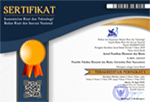BRAND IMAGE AS A MEDIATION OF ELECTRONIC WORD OF MOUTH ON PURCHASING INTENTION OF LANEIGE
DOI:
https://doi.org/10.33633/jpeb.v5i2.3270Abstract
The purpose of the study was to know and analyze the role of brand image as a mediator of the impact of the Electronic Word of Mouth on purchasing intention of Laneige’s product. A sample of 100 respondents used a purposive sampling technique. The type of test used to analyze the data was the validity and reliability test. The data analysis technique used is path analysis. The results of the Electronic Word of Mouth study have a significant and positive effect on brand image and purchasing intention. The Brand image also has a significant and positive impact on purchasing intention and directly has a role as a mediator on the impact of Electronic Word of Mouth on purchasing intention of Laneige’s Product.Keywords: Electronic Word of Mouth; Brand Image; Purchasing IntentionReferences
Assael, H (2004). Consumer Behavior and Marketing Action, Edisi 3, Cincinatti: SouthWestern College Publishing
Chang, Hsin-Hsin & Liu, Ya-ming. (2009). The Impact of Brand Equity on Brand Preference and Purchasing Intention. Service Industries Journal, 29 (12), 1687-1706
Chartterjee, P. (2001). Online Review: Do Consumer Use Them?. Advances in Consumer Research, 28 (1)129-133.
Chevalier, J.A. & Mayzlin, D. (2006). The Effect of Word of Mouth on Sales: Online Book Reviews. Journal of Marketing Research, 43 (3), 345-354
Hennig-Thurau, T., Gwinnwe, K.P., Walsh, G. & Gremler, D. D. (2004). Electronic Word-of-Mouth via Consumer-Opinion Platforms: What Motivates Consumer to Articulate Themselves on the Internet?. Journal of Interactive Marketing, 18 (1), 38-52.
Hu, N., Pavlou, P. A., & Zhang, J. (2006). Can Online Reviewa Reveal a Product’s True Quality?: Empirical Findings and Analytical Modeling of Online Word-of-Mouth Communication. In J. Feigenbaum, J. Chuang, & D. M. Pennock (Eds.), Proceedings. Presented at The 7th ACM Conference on Electronic Commerce.
Jalilvand, Mohammad Reza & Neda Samiei. (2012). The Effect of Electronic Word of Mouth on Brand Image and Purchasing Intention: An Empirica; Study in The Automobile Industry in Iran. Marketing Intelligence & Planning, 30 (4), 460-476.
Kotler, Philip & Keller. (2012). Manajemen Pemasaran Edisi Ketigabelas. Jakarta: Erlangga
Kuwara, Yasue. (2014). The Korean Wave: Korean Popular Culture in a Global Context. New York: Parlave Macmillan.
Litvin, Stephen W; Ronald E. Goldsmith & Bing Pan. (2008). Electronic Word-of-Mouth In Hospitalty and Tourism Management. Collage of Business and economics.
Marbun, B. N. (2003). Kamus Manajemen. Jakarta: Ghalia Indonesia.
Morissan, M.A. (2010). Periklanan: Komunikasi Pemasaran Terpadu Edisi 1. Jakarta: Kencana.
Reza M, Maulana & Widowati Retno. (2018). Pengaruh Electronic Word of Mouth Terhadap Minat Beli Melalui Citra Merek dan Kepercayaan Merek Sebagai Variabel Intervening.Thesis.Yogyakarta: Universitas Muhammadiyah Yogyakarta.
Samuel, Hatane & Lianto, Adi Suryanata. (2014). Pengaruh Analisis eWOM, Brand Image, Brand Trust, dan Minat Beli Produk Smartphone di Surabaya. Jurnal Manajemen Pemasaran, 8 (2).
Schiffman, Leon & Kanuk, Leslie Lazar. (2008). Perilaku Konsumen. Jakarta: PT. Indeks Gramedia.
Semuel, H & Wijaya, E. (2008). Corporate Social Responsibility, Purchasing Intention, dan Corporate Image pada Restoran di Surabaya dari Perspektif Pelanggan. Jurnal Manajemen Pemasaran, 3, 35 – 54.
Stelzer, Michael A. (2016). Social Media Marketing Report: How Marketers Are Using Social Media to Grow Their Businesses. SocialMedia Examiner
Wang, Xhuehua & Yang, Zhilin. (2010). The Effect of Brand Credibility on Consumers Brand Purchasing Intention in Emerging Economies: The Moderating Role of Brand Awareness and Brand Image. Journal of Global Marketing, 23, 177-188
Downloads
Published
How to Cite
Issue
Section
License
The copyright of the received article shall be assigned to the journal as the publisher of the journal. The intended copyright includes the right to publish the article in various forms (including reprints). The journal maintains the publishing rights to the published articles.
This work is licensed under a Creative Commons Attribution 4.0 International License.


.png)









